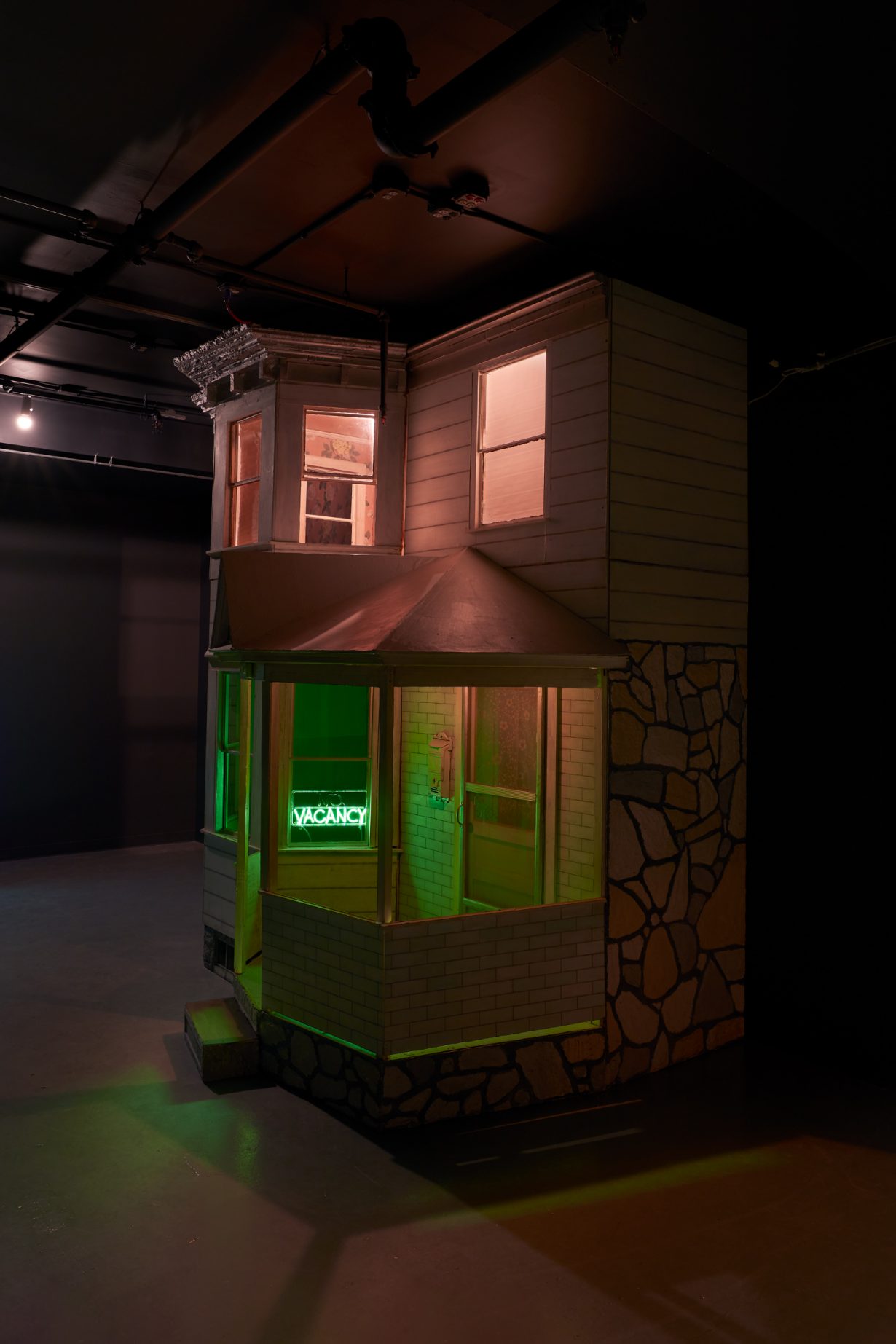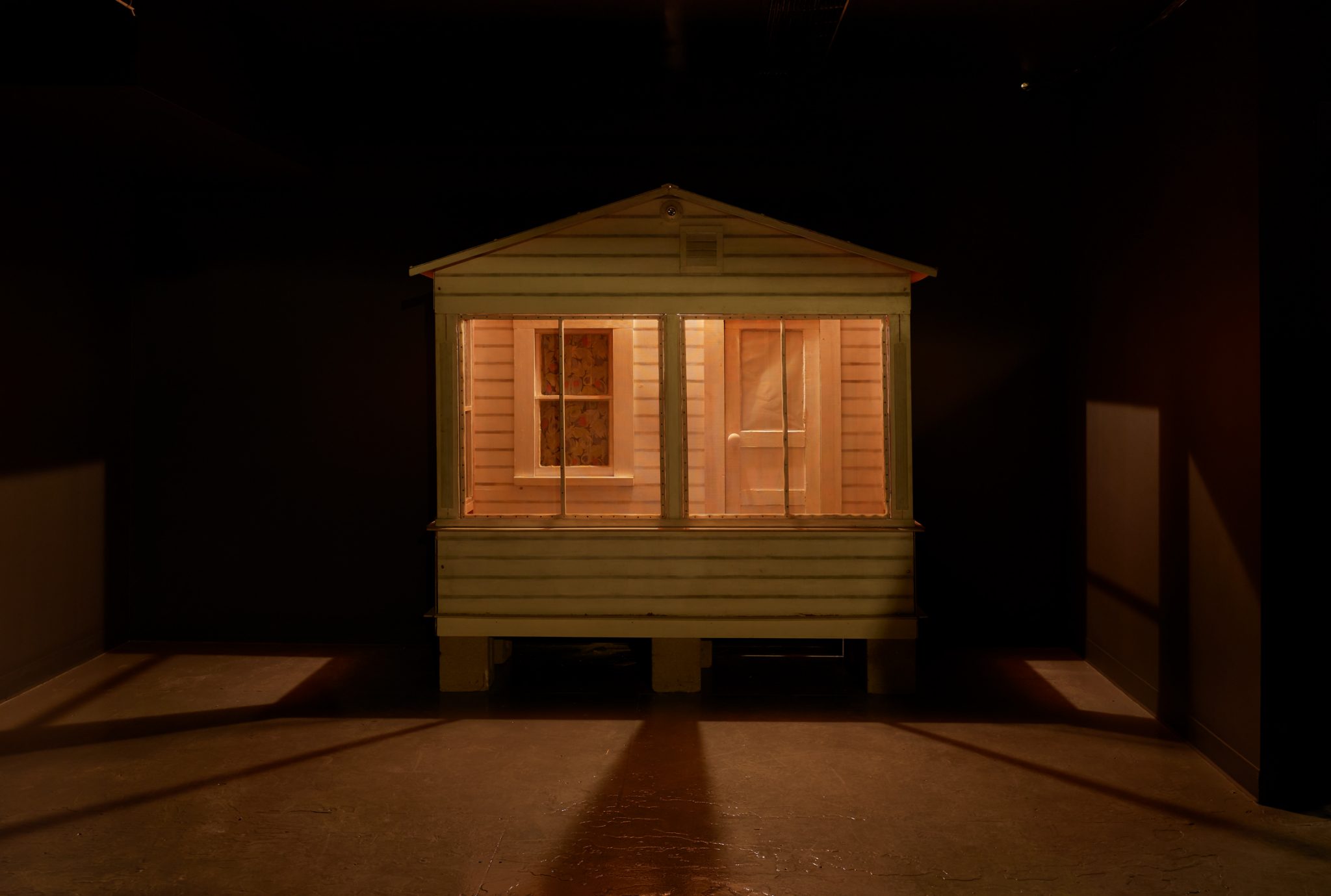Houses and Hotels at O’Flaherty’s, New York, furthers the artist’s interest in the literal and psychological ‘interiors’ of dwellings
In the semidarkness is a rowhouse, its siding a pastiche of brick, clapboard and stone. Hinting at the absent occupants’ taste, floral wallpaper lit by a bare bulb peeks out of a second-storey window; downstairs, a bay window theatricalises an empty room where the wall clock is perpetually set to 6:05. Despite its illuminated ‘vacancy’ sign, this house offers no entry; Donna Dennis’s Two Stories with Porch (for Robert Cobuzio) (1977–79) is about three metres tall.
Too large for a manipulable model and too small for a habitable dwelling, the structure – which is based on a tollbooth by the Holland Tunnel and a New Jersey home from a George A. Tice photograph, and memorialises a New Jersey-born friend – is one of five American vernacular follies that comprise Houses and Hotels, an oneiric show of the artist’s early installation works from 1972 to 1994. Predominantly displayed in a darkened room with a perspectivally unsettling, sloped floor, the architectures draw on various buildings, including those sourced from memories, photographs, fantasies and literature. Cobbled together from humble materials and marked by regional aesthetics (the East Coast rowhouse, the Midwestern cabin), the gently dilapidated dwellings hint at the needs, means and social lives of their imagined inhabitants. Houses, as Dennis’s evocative creations remind us, are always containers for ‘stories’: both as settings where lives unfold, and as structures that materially reflect broader sociocultural and economic histories.
In the decades following her participation in such prominent exhibitions as the Whitney Biennial (in 1979) and the Venice Biennale (in 1982), Dennis had a smaller footprint. Arriving on the heels of the publication of her monograph by Monacelli last year, this exhibition – which coincides with the release of her journals from Bamberger Books – marks the octogenarian’s well-deserved return to the spotlight. The Ohio-born artist, who moved to New York City during the 1960s, got her start as a figurative painter; her depictions of automobiles anticipated her interest in everyday infrastructure. Contemporaneous painters of the minimalist and hard-edge variety were working with shaped canvases that blurred the lines between painting and sculpture. At the outset of the 1970s, Dennis turned to shaped canvases of her own: hotel facades. Hotel Pacifica (1972), a narrow front labelled ‘hotel’, collapses the distinction between painting, sculpture and architecture while evoking an unsound world in which buildings are just stage flats. (From flimsily constructed hotels that serve as theatres for fantasies, to once-solid homes made temporary by gentrification’s raze-and-replace, it’s a fair assessment.) Scaled to the artist’s height – indicating that her size, rather than a man’s, was the unit on which this built environment was based – the doorway mixes trompe l’oeil latticework with three-dimensional blinds. An aquacoloured light shines from behind the slats, winkingly riffing on Dan Flavin’s fluorescent sculptures; Dennis embraced Minimalism’s material innovations – specifically its use of light and industrial materials – and shared its investment in the built environment without subscribing to its dogmas.

In 1976 Dennis embarked upon her ‘Tourist Cabin’ works, humble wooden shacks that began more facadelike – Tourist Cabin Porch (Maine) (1976) consists of the front of a cabin with a porch – but evolved into compressed interiors – Tourist Cabin with Folded Bed (1986) is a hutch containing a cot and a suitcase (concealing car batteries that power lighting). As increasing dimensionality evinced Dennis’s interest in the literal and psychological ‘interiors’ of dwellings, the cabin form reflected her mounting desire, as she has written, to wrestle with her lived experiences in her work, in light of her participation in feminist consciousness-raising groups. Underscoring that architectural categories such as ‘cabin’ are shifting amalgamations of personal experiences and cultural texts, rather than stable or coherent entities, she based the ‘Tourist Cabins’ on a kaleidoscope of sources: the cabins where she stayed during childhood roadtrips in the Midwest; Walker Evans’s Depression-era photographs of cottages at the Ossining Campwoods in New York; and in the case of Cataract Cabin (1994), a New Hampshire cabin and Jane Bowles’s short story ‘Camp Cataract’ (1949), about the fraught relationships between sisters.
Located in a room of its own, Cataract Cabin is a white clapboard shanty perched atop a gargantuan boulder alongside a small blue rowboat. The installation was originally displayed outdoors, and the ceiling of the gallery has been cut to make room for its height. While the house’s illuminated interior is largely obscured, there is a clear view of a screened-in porch – a liminal space between inside and outside – in which a few mesh screens are stacked like forgotten projects. The boulder is riven. Crouching to peer into its fault line reveals a simple wooden chair and a dirt-streaked mirror. As the architectural plot unfolds upstairs, a subterranean narrative – the tendency of buildings to lodge themselves in psyches, stunningly expressed here – holds us in its grip.
Houses and Hotels at O’Flaherty’s, New York, 9 March – 28 April
An earlier version of this review incorrectly attributed information about details of the work Two Stories with Porch (for Robert Cobuzio) (1977–79) to a press release.
